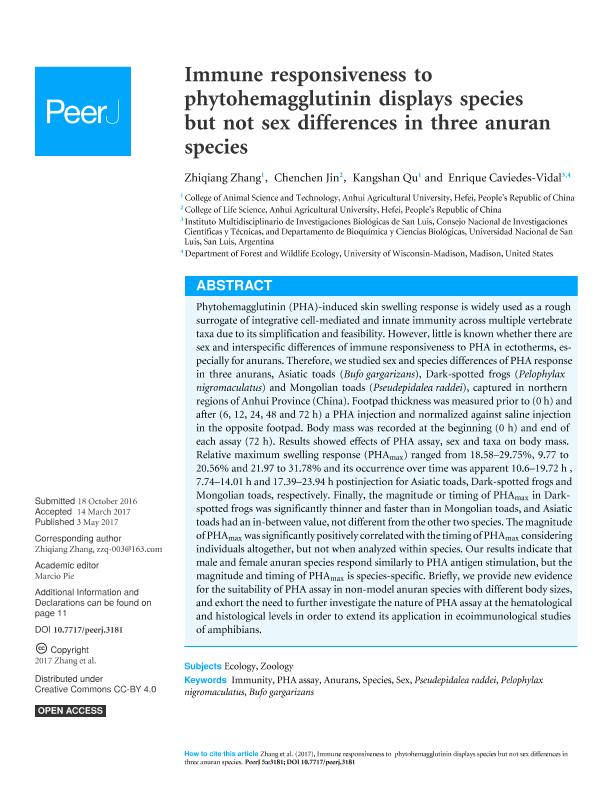Mostrar el registro sencillo del ítem
dc.contributor.author
Zhang, Zhiqiang
dc.contributor.author
Jin, Chenchen
dc.contributor.author
Qu, Kangshan
dc.contributor.author
Caviedes Vidal, Enrique Juan Raul

dc.date.available
2019-01-16T17:59:25Z
dc.date.issued
2017-05
dc.identifier.citation
Zhang, Zhiqiang; Jin, Chenchen; Qu, Kangshan; Caviedes Vidal, Enrique Juan Raul; Immune responsiveness to phytohemagglutinin displays species but not sex differences in three anuran species; PeerJ; PeerJ; 2017; 5; 5-2017; 1-17; e3181
dc.identifier.issn
2167-8359
dc.identifier.uri
http://hdl.handle.net/11336/68137
dc.description.abstract
Phytohemagglutinin (PHA)-induced skin swelling response is widely used as a rough surrogate of integrative cell-mediated and innate immunity across multiple vertebrate taxa due to its simplification and feasibility. However, little is known whether there are sex and interspecific differences of immune responsiveness to PHA in ectotherms, especially for anurans. Therefore, we studied sex and species differences of PHA response in three anurans, Asiatic toads (Bufo gargarizans), Dark-spotted frogs (Pelophylax nigromaculatus) and Mongolian toads (Pseudepidalea raddei), captured in northern regions of Anhui Province (China). Footpad thickness was measured prior to (0 h) and after (6, 12, 24, 48 and 72 h) a PHA injection and normalized against saline injection in the opposite footpad. Body mass was recorded at the beginning (0 h) and end of each assay (72 h). Results showed effects of PHA assay, sex and taxa on body mass. Relative maximum swelling response (PHAmax) ranged from 18.58-29.75%, 9.77 to 20.56% and 21.97 to 31.78% and its occurrence over time was apparent 10.6-19.72 h, 7.74-14.01 h and 17.39-23.94 h postinjection for Asiatic toads, Dark-spotted frogs and Mongolian toads, respectively. Finally, the magnitude or timing of PHAmax in Darkspotted frogs was significantly thinner and faster than in Mongolian toads, and Asiatic toads had an in-between value, not different from the other two species. The magnitude ofPHAmax was significantly positively correlated with the timing ofPHAmax considering individuals altogether, but not when analyzed within species. Our results indicate that male and female anuran species respond similarly to PHA antigen stimulation, but the magnitude and timing of PHAmax is species-specific. Briefly, we provide new evidence for the suitability of PHA assay in non-model anuran species with different body sizes, and exhort the need to further investigate the nature of PHA assay at the hematological and histological levels in order to extend its application in ecoimmunological studies of amphibians.
dc.format
application/pdf
dc.language.iso
eng
dc.publisher
PeerJ
dc.rights
info:eu-repo/semantics/openAccess
dc.rights.uri
https://creativecommons.org/licenses/by/2.5/ar/
dc.subject
Anurans
dc.subject
Bufo Gargarizans
dc.subject
Immunity
dc.subject
Pelophylax Nigromaculatus
dc.subject
Pha Assay
dc.subject
Pseudepidalea Raddei
dc.subject
Sex
dc.subject
Species
dc.subject.classification
Otras Ciencias Biológicas

dc.subject.classification
Ciencias Biológicas

dc.subject.classification
CIENCIAS NATURALES Y EXACTAS

dc.title
Immune responsiveness to phytohemagglutinin displays species but not sex differences in three anuran species
dc.type
info:eu-repo/semantics/article
dc.type
info:ar-repo/semantics/artículo
dc.type
info:eu-repo/semantics/publishedVersion
dc.date.updated
2018-10-23T17:40:09Z
dc.journal.volume
2017
dc.journal.number
5
dc.journal.pagination
1-17; e3181
dc.journal.pais
Estados Unidos

dc.description.fil
Fil: Zhang, Zhiqiang. Anhui Agricultural University; China
dc.description.fil
Fil: Jin, Chenchen. Anhui Agricultural University; China
dc.description.fil
Fil: Qu, Kangshan. Anhui Agricultural University; China
dc.description.fil
Fil: Caviedes Vidal, Enrique Juan Raul. Consejo Nacional de Investigaciones Científicas y Técnicas. Centro Científico Tecnológico Conicet - San Luis. Instituto Multidisciplinario de Investigaciones Biológicas de San Luis. Universidad Nacional de San Luis. Facultad de Ciencias Físico Matemáticas y Naturales. Instituto Multidisciplinario de Investigaciones Biológicas de San Luis; Argentina
dc.journal.title
PeerJ
dc.relation.alternativeid
info:eu-repo/semantics/altIdentifier/doi/http://dx.doi.org/10.7717/peerj.3181
dc.relation.alternativeid
info:eu-repo/semantics/altIdentifier/url/https://peerj.com/articles/3181/
Archivos asociados
